The Altissa Altix I was first build in Dresden, Germany, in 1939. Production of the first model continued shortly after the war and was soon followed by models II and III. These were all small and relatively simple viewfinder cameras with square 24x24mm frame sizes, smaller than the more common 35x24mm format. Several had lenses that were in principle interchangeable, but few lenses with focal lengths other than standard lenses appear to have been built. The first Altissa using the standard 35x24mm format was the Altissa IIIA.
The first Altix had a rather peculiar styling with a small lens on a large, square lens base. There were several variants, the first model had a fixed focus lens, later version had simple zone focusing (near and far) or focal distance indicators. Because of the small 24x24mm film format the camera was relatively compact.
Despite its simplicity, the camera had a reasonable range of apertures of f/3.5 to f/16 and four shutter speeds from 1/25 to 1/150 plus a B setting. It also featured double exposure prevention, a small button on the top plate was there to reset the wind lock mechanism after each exposure. On later models this was no longer there, its function being taken over by a button at the back.
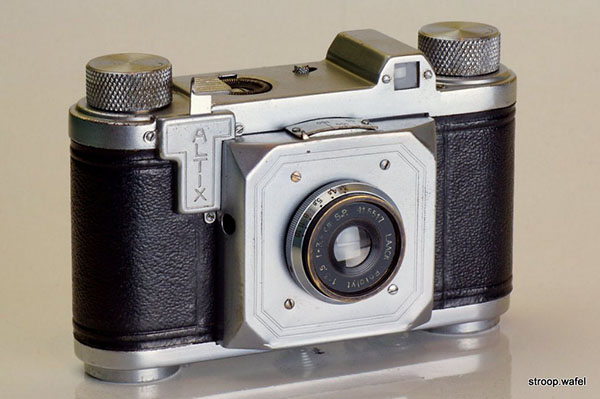
|
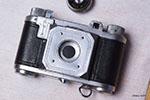
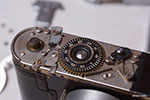
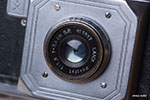
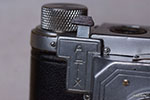
|
(top) The first, pre WWII version of the Altix Altissa Altix I with fixed focus Laack Pololyt lens (although one could in fact partially unscrew the lens to achieve better focus at close distances).
(bottom from left to right) Altix I with lens removed; winding and frame counter mechanism, close-up of the LAACK Pololyt lens; the Altix name plate.
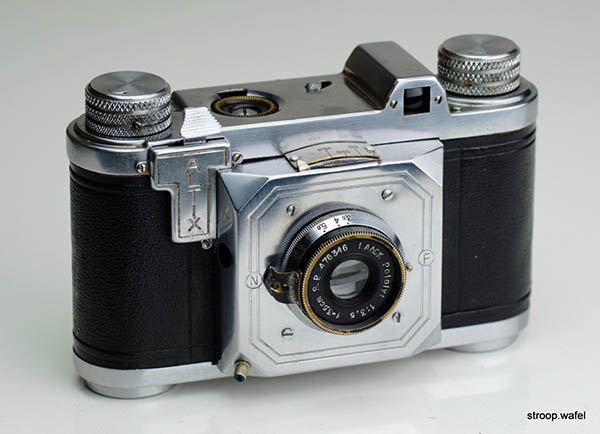
The most common model of the Altix I with N (near) and F (far) markers which allowed it to focus at close distance, unlike the model above . There are small cosmetic differences between the Altix I versions, note for example the wind knobs which differed from the one above. Also, the lens had a slightly extended aperture range up til f/18.
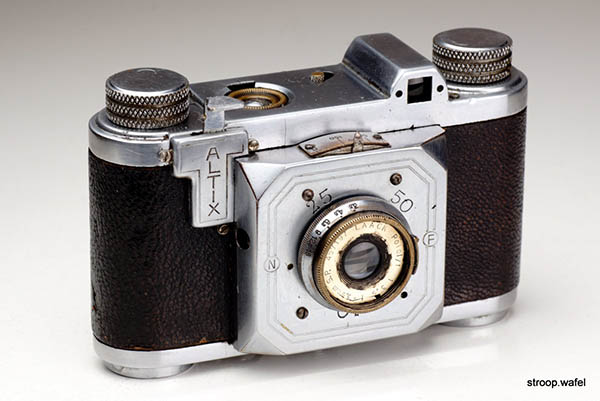
A peculiar version of the Altix I with distance indicators in feet engraved on the lens base plate. The N (near) and F (far) markers of an earlier zone-focussing version are still present also. This does not appear to be an official version of the camera, so probably the focus indicators were a later modification. If so, it was certainly very professionally done.
Unfortunately the lens on this example did not receive the same exemplary treatment, it used to be black but the paint has been rather crudely removed by a previous owner.
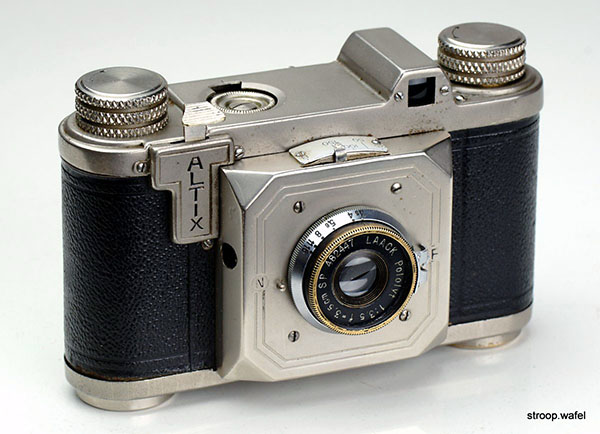
A later version of the Altix I, presumably from around 1947, so post WWII as opposed to the examples above. It appears to be rather rare, I have seen this version less often even than the fixed focus version above. There were only few changes compared to pre-war models, most notably the simplication of the wind lock mechanism, so it lost the button on top of the top plate. Also, this example was nickel plated, not chrome plated like the other ones above. This was a little surprising as already before WWII chrome plating had all but replaced nickel plating. Presumably chrome or the chemicals needed for plating were hard to get in postwar East Germany.
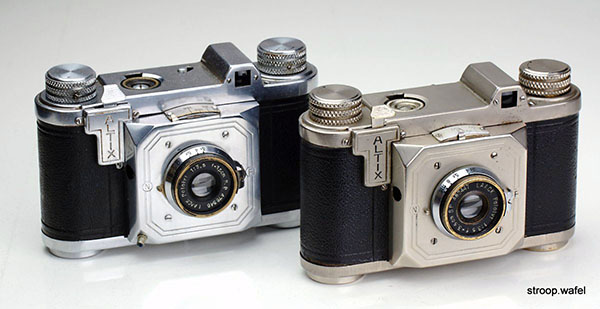
Pre (left) and post (right) war models of the Altix I side by side. The most noticable difference is the chrome vs. nickel plating, respectively.
Altix II
The rather rare second model from 1948 was functionally nearly identical to the Altix I but had a different front plate and had therefore a more rounded look. Also this model had reasonably impressive specs despite its apparent simplicity: a Compur-Rapid shutter with a fastest shutter time of 1/500 and including slow speeds down to 1s, a fast f/2.9 Steinheil Cassar lens and even a time delay that was activated by pulling back a small knob on top of the shutter during cocking. It allowed focussing from 2m to infinity.
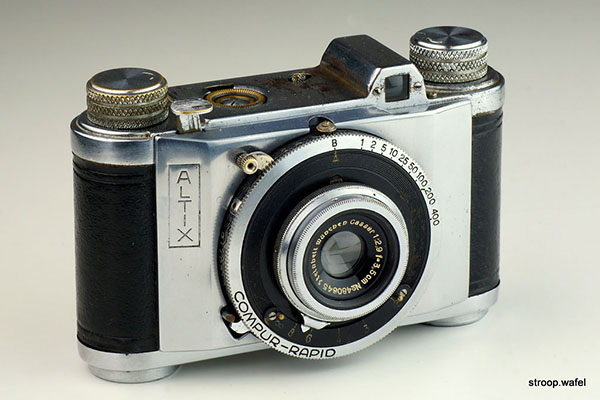
An Altix II with some corrosion and brassing of the topplate and wind knob.
Altix III
The Altix III had a front plate of mostly leather and the shutter release was moved to the middle of the top plate. It was still rather compact due to its smaller film frame size. Quite a few varieties exist, with different shutters, lenses and positions of the flash sync. Most have interchangeable lenses in the sense that the lenses can easily be unscrewed, but there appear to be no other lenses than standard lenses apart from a Ludwig Meritar 50mm f/2.9 telelens (standard lens for 24x24 frame is 35mm). The lenses have a 22.5mm screw thread. The whole lens moves during focussing, which is comparable to helical focussing, in contrast with front cell focussing on many lower-spec cameras.
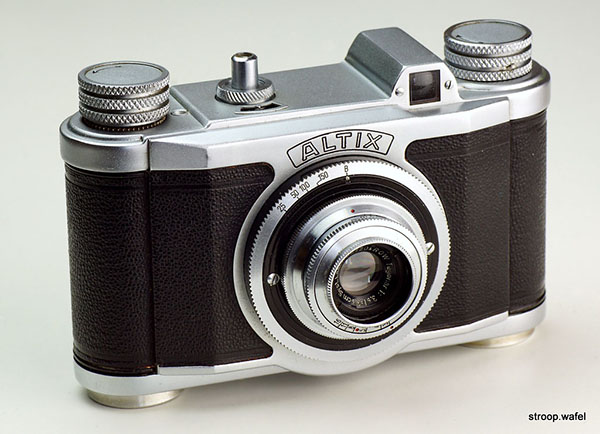
|
An early Altix III with an interchangeable Laack Tegonar lens and an unmarked self-cocking shutter. These cameras are a little frustrating to work on as to remove the top plate one needs to remove the front plate, including the leather covering. A big ask for cleaning a hazy viewfinder! Luckily this one came in perfect condition.
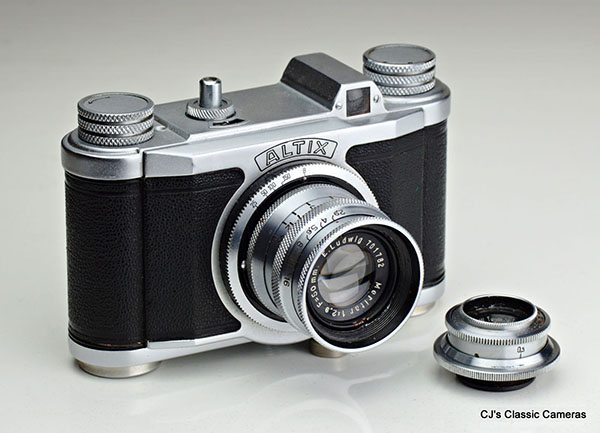
|
Same camera with 50mm f/2.9 Meritar 'telelens' mounted, and with its rather miniscule standard Laack Tegonar lens on the side. The camera had no accessory shoe to which a different viewfinder could be fitted and I am not aware of any masks being produced to adopt the standard viewfinder for the longer focal length, so it appears a little guesswork may have been needed to use this lens. There is a frame carved in the front viewfinder glass (impossible to see in the photo) but it's close to the edge of the viewfinder, so I don't think this is to show the telelens frame. It's barely visible looking through the viewfinder anyway.
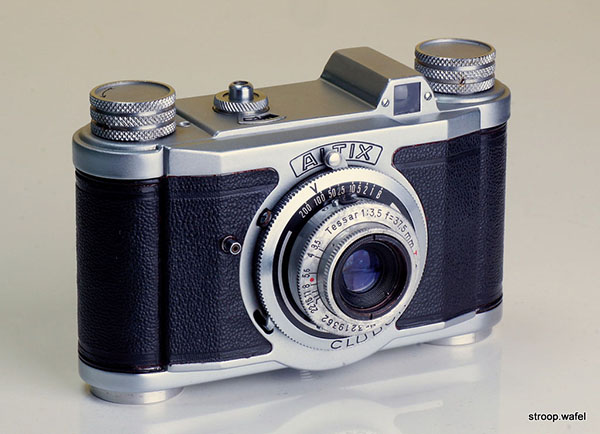
|
A late Altix III with a fixed Carl Zeiss Tessar lens. The T means the lens is coated.
Altix IIIA
The last version (1952-1954) of the Altix III was designated the IIIA and was the first Altix with a 'standard' 36x24mm film frame. It therefore sported a larger lens with a wider diameter and screw thread. Although the flange distance was about the same as for the Altix III models, the actual lens was sat further from the film plane to allow coverage of the whole 24x36 film frame. The 'ALTIX' markings moved from the front plate above the shutter to the top plate, like on the later Altix IV model.
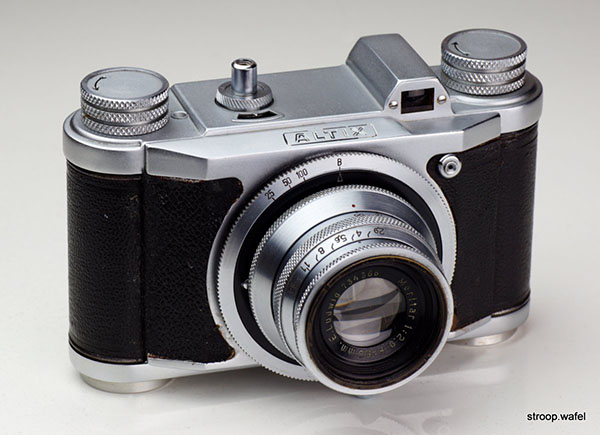
|
An Altix IIIA with interchangeable Ludwig Meritar 50mm f/2.9 lens and unmarked self-cocking shutter, which only had three speeds + a B setting.
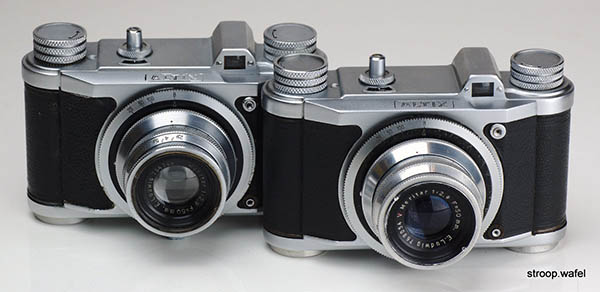
|
Two different versions of the Meritar existed, as shown here. The later version (on the right with serial# 768054) was coated, as indicated by the V on the lens ring and the blueish colour of the reflections in the lens, but it looked otherwise very similar to the earlier version shown on the left (serial# 734366). However, the difference was very noticeable when one would pick up the lenses: the older one was nearly three times as heavy! It was probably made of brass, whereas the later version was made of aluminium. The early version was in fact heavy enough to topple over the camera, whereas with the later version the camera stands straight up without needing support.
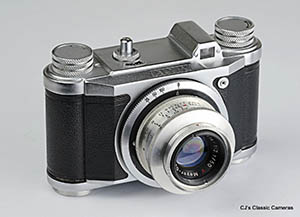
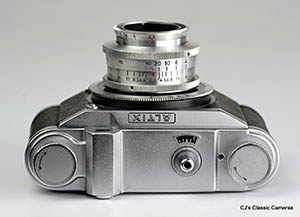
|
The Altix IIIA was also available with a slightly faster, higher quality, and nowadays quite rare, Meyer-Optik Primotar 50mm f/2.7 lens. Like the later version of the Meritar shown above, this lens was made from aluminium, which explains the slightly different colour to that of the (chrome-plated) body. This lens has an unusual optical formula. The rear group behind the aperature consists of two lens elements, whilst the composition of the single group front cell is hard to see based on the reflections you get by shining light through the lens, but this group a triplet according to this website. It's hard to see from the reflections you get by shining light through the lens. I've not seen a similar formula before and it is quite different from other five-element standard lenses such as the f/2.8 Super-Xenar or the Corfield Lumax f/1.9.
Altix IV
Production of the Altix IV started in 1952 and continued till 1959. It had a fixed 50mm lens with helical focus, an accessory shoe and it used the standard 36x24mm film format. Similar to previous models it was a bottom-loading camera: the bottom plate would come off and an uptake spool needed to be inserted. A flap that opens at the back made loading easier.
Quite a few changes were made to the camera during production, including the wind knobs, flash sync socket, name engravings and the shutter plate. In addition, it was available with three different lenses, an f/3.5 or f/2.8 Carl Zeiss Tessar, a f/2.9 Meyer Trioplan and a rare f/2.9 Ludwig Meritar. An export version was sold under the name 'Classic 35' and a late batch of cameras were build under license in Sarajevo, former Yugoslavia, mainly recognisable by the ZRAK logo imprinted in the leather of the back of the camera (see below).
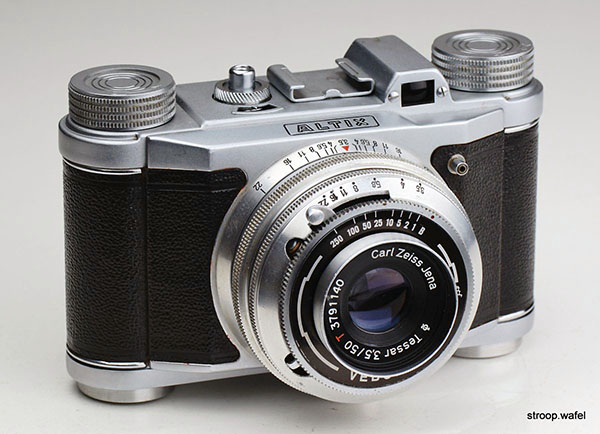
An early Altix IV with name markings engraved in capitals.
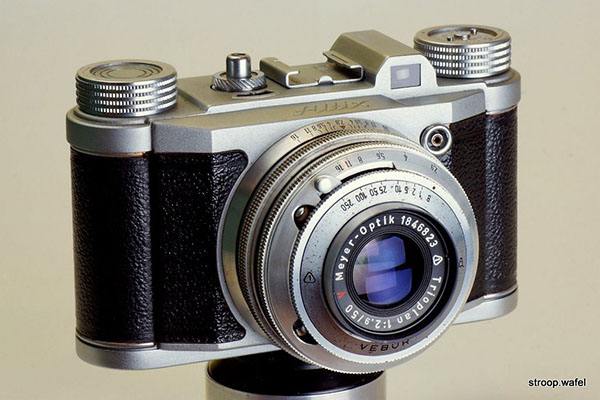
A late Altix IV with italic engraved name markings. A new feature was the film reminder in the rewind knob.
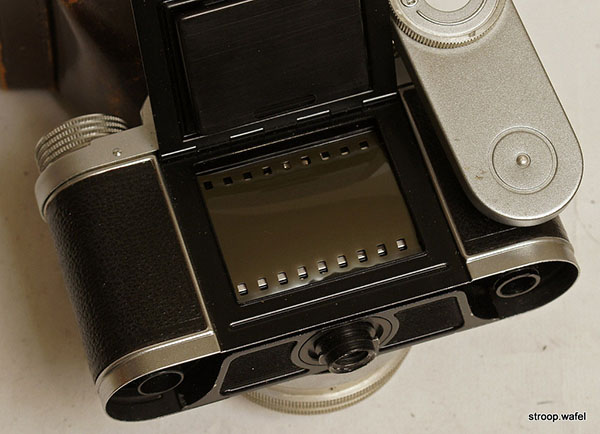
Backside of an Altix IV with bottom plate removed and film loaded.
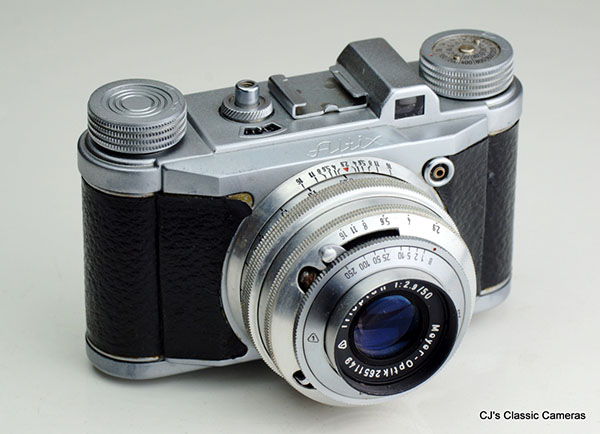
As mentioned above, some Altix IV were made under license in former Yugoslavia, the so-called Yugo-Altix. The example shown here is one of those, it is identical to the 'italic' Altix IV above, except for the leather which has a coarser texture and the the logo on the rear (see below).
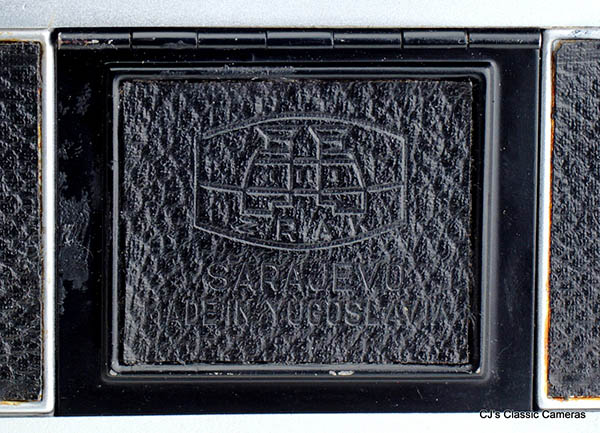
Detail of rear door of the Yugo Altix above. It bears the ZRAK Sarajevo company logo and states 'Made in Yugoslavia'. One other detail set these cameras apart: the numbering. This one has serial# 11 298, whereas regular Altix IV preceding the Yugo version had numbers in the 200 000 range.
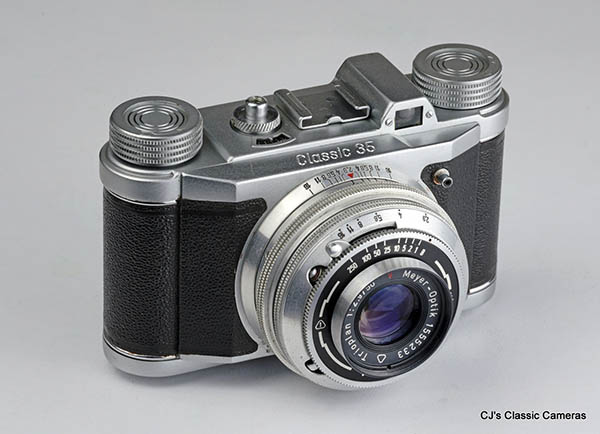
A rare export version of the Altix IV branded 'Classic 35'. It was made specifically for the North American market, as the Altix IV was for sale under its original name in e.g., the UK. Despite the 'Classic 35' engraving in italics, it was more similar to the first Altix IV model with 'capital engraving'.
Many thanks to Stefan Lange for finding this example for me.
IOR Bucuresti Orizont
This is technically not an Altix camera, but no doubt closely related. Around 1960 production of Altix cameras in Germany stopped, but production of the Altix IV was for a while continued by ZRAK Sarajevo in former Yugoslavia. In addition, a camera very much based on the Altix IV was built in Romania by IOR Bucuresti, although it is not clear if this was under license or just a copy. This camera was the IOR Orizont. It featured a Trioclar 50/3.2 lens and a simple shutter with three speeds and T. Apparently only about 2000 were built although it is unclear where this estimate comes from. It is nowadays hard to find good copies as the metal plating corroded easily. The black plastic faux-leather is from brittle plastic and often damaged.
There is also a second version with film reminder in the rewind knob and a different shutter in silver rather than black.
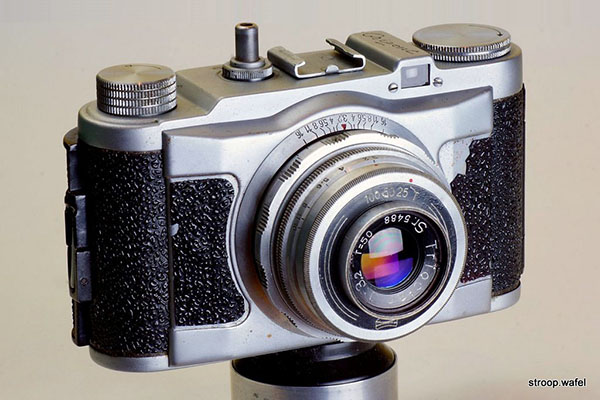
|
An IOR Orizont in reasonable condition but with some missing plastic covering. When I received it someone had painted the missing parts rather untidily with a black marker! I think it looks better this way. It has the same issue as most Altix cameras: one needs to dismantle most of the camera just to clean the viewfinder.
Eho Altiflex
Altissa didn't just make 35 mm cameras. Like most camera makers from that that time (1920s-1930s), they started out with medium format box cameras, initially under the brand name Eho, and after changing ownership, the company introduced the Altiflex, a TLR camera, as well as a new line of box cameras called the Altissa.
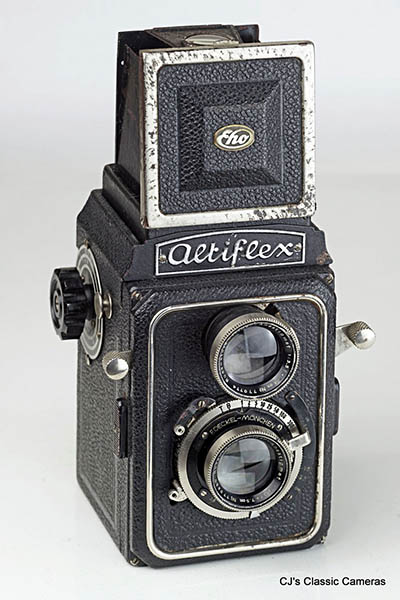
| |
A 1937 Altiflex with Rodenstock-Trinar-Anastigmat lens 75mm f/3.5 in Compur shutter. This example still carries the brand name 'Eho', after the original owner Emil Hofer, even the company had already been taken over by Berthold Altmann, who introduced the Altissa name.
|
Super Altissa
The Super Altissa was a small medium-format box camera for 6x6 photos on 120 rollfilm. It had an eye-catching art-deco style front plate and a long viewfinder mounted on top of the camera. This is by far the smallest 6x6 format camera I have in my collection, and it had to believe it's the same format as the comparably gigantic and heavy Pentacon Six, or any of the Rolleiflexes for that matter. Sure, this little camera didn't have all the fancy features, but with a decent lens it was capable of good pictures and it was no hassle to carry around all day long.
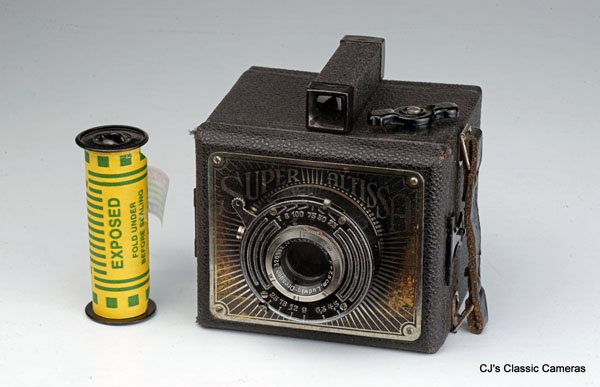
An Altissa Super with Ludwig Victar 75 mm f/4.5 lens in unbranded shutter of unclear origin. The shutter trigger is the same as found on the Stelo and Junior shutters made by Gebr. Werner which is seen on other cameras from that part of Germany (around Dresden), so I suspect they are the source of the shutter. The same shutter can be found on my Rodenstock Rodella (rebranded Merkel Metharette) which I have yet to add to this website.
My photo doesn't really do the shiny front plate with sun ray motif justice. Note it's barely larger than the film roll that goes in it.
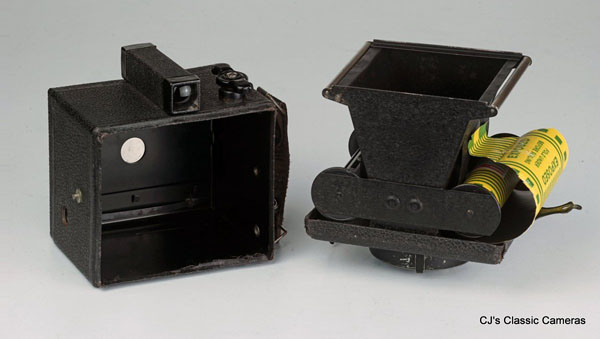
| |
An Altissa Super with the back removed, showing the film wind assembly mounted onto the front of the camera.
|

